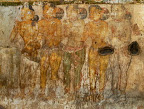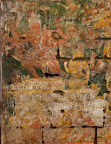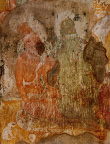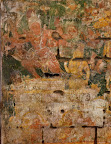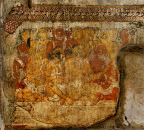Of all arts the best is chitra. It gives the fruit of dharma, artha, kama, and moksha. Wherever it is established in a house (or otherwise), it is harbinger of auspiciousness.
Chitrasutra of the Vishnudarmottara, (translation by C.Sivaramamurthy)
Mural paintings formed an integral part of India’s built heritage. The texts prescribe that the built heritage needs to be decorated in a large scale. Accordingly, the ancient built heritage of India, particularly temples, were decorated with murals almost covering the entire surface area of the structures. The art of painting in India is so varied and evolved in an impressive spectrum with time. Vibrant colours were used to paint themes, often influenced by the great and intricate knowledge of the literary corpus of our country. The technique adopted in preparing the ground and pigments were sound and in many places they have stood the test of time. But, in large number of cases, they are fast disappearing not due to the fault of the painter or his technique but due to external conditions like the structural problems, location problems and above all foolish and senseless vandalism. The Academy plans to undertake very sensitive task of preservation of mural paintings found on our built heritage, particularly in Temples of Tamil Nadu.
Mural Traditions
There is a rich tradition of mural paintings in Tamil Nadu. Casual painters have left their creative genius in the form of rock paintings. There are numerous rock-shelter with paintings datable to 3000 years before present and earlier in red ochre/white kaolin along the hillocks bordering the western Tamil Nadu. These are wonderful sites with full potential for development as heritage tourism spot. Fortunately, the pigments have formed a matrix with the rock surface due to natural chemical reactions and hence require little intervention from us for their preservation for posterity. The sites require to be guarded from vandalism by locals who are ignorant of the creative genius of their real ancestors. At the Academy we are planning to develop a network of well informed local guides at these places.
The mural traditions further continued on the built heritage. The ancient literary works like Silappadikaram mentions about the painted palaces. But none of them is preserved today. There is an impressive array of references to a well developed system of art in ancient India with highly informed and knowledgeable patrons, talented artists and highly critical critiques who can separate an ordinary work from an immortal one.
In Tamil Nadu, the remains of murals at the famous Kailasanatha temple at Kanchipuram and Talagirisvara temple at Panamalai (near Gingee, Villupuram District) belong to the early 8th Century and patronised by the Pallava king Rajasimha II (AD700-727), followed by the remains at the Jaina cave at Sittanavasal (near Pudukkottai) , patronised by the Pandyan king, Narttamalai, painted during Early Chola period (during 10th century), the famous murals in the circumambulatory of the sanctum sanctorum of the Brihadisvara temple, Tanjavur, possibly conceived and meticulously executed under the direct supervision of the Rajaraja, the greatest Chola ruler, during early decade of 11th century are all well known. The later Chola paintings at Tirumalai are a class in themselves.
But during the rule of Vijayanagara and later Nayaka dynasties, the temple Architecture saw an exponential growth. Numerous expansive additions were made. And invariably they were all richly painted in tempera technique but with inferior execution. This compendium of paintings found in sketchy remains requires our attention very urgently. As significant feature of these late paintings are they reflect the many secular and moral themes seamlessly integrated into well known mythological themes.
Present condition and Academy’s role
At many places, due to their poor preservation, these wonderful paintings are vandalised by the educated persons themselves. They were happy to scrap them and remove them permanently or apply a coat of thick lime wash over it. Sad part is that this practice is being continued even today. As result, what was seen as masterpiece about four decades ago at Tiruvalanchuli (near Swamimalai, Tanjavur District) and Tiruvellarai (near Villupuram) were all now gone forever.
Yet another aspect is that there are very few experts in this field today and they are too old. There is a dire need for creating a talented pool of experts. This can only be done through by taking many projects of preservation so that these experts could be sustained.
The murals listed above are safe as they are protected by the Archaeological Survey of India. But the large compendium of murals is in temples under active use. Therefore the pressures are more either to obliterate them or to over enthusiastically repaint them.
Therefore, the Academy has taken preservation of mural paintings as its prime objective.
For the present the Academy has identified the following projects- Varadrajaswamy temple, Kanchipuram, Siva temple at Avudaiyarkoil,
Avudaiyarkoil
Panamalai
Tanjavur







